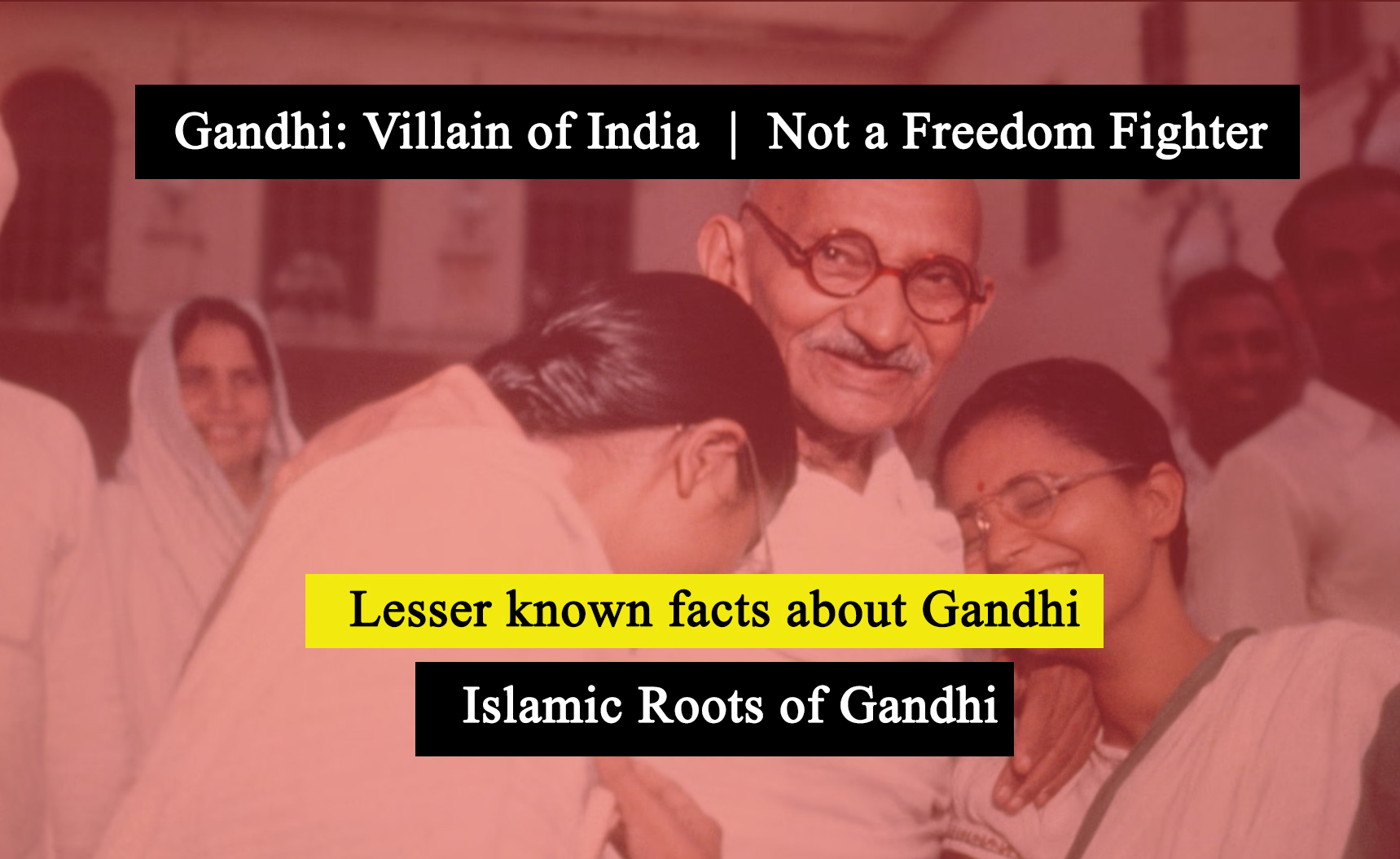Mohandas Karamchand Gandhi, often hailed as the “Mahatma” or “Great Soul,” is a figure shrouded in a carefully crafted myth of non-violence and unity. But beneath this façade lies a troubling reality—one of Islamic leanings, anti-Hindu bias, and a legacy of betrayal that cost countless Hindu lives. This article dives into lesser-known facts about Gandhi, exposing his pro-Muslim stance, his hypocrisy masked as non-violence, and his shameless personal experiments that reveal a man devoid of true integrity. Far from being a saint, Gandhi emerges as a villain—a traitor to Hindus and a puppet of divisive forces.
The Islamic Roots of Gandhi
A Family Tied to Muslim Influence
Gandhi’s origins tell a story far removed from the Hindu hero narrative. Born to Karamchand Gandhi and his fourth wife, Putlibai, Mohandas entered a world already steeped in Islamic ties. Putlibai belonged to the Pranami sect, a group some scholars, like Prof. K.S. Narayanacharya, describe as an Islamic organization cloaked in Hindu guise. This sect blended Islamic ideas with Hindu traditions, creating a hybrid that leaned heavily toward Muslim theology. Gandhi’s mother, therefore, was not a typical Hindu devotee but a product of this Muslim-influenced cult.
The scandal deepens with Karamchand Gandhi’s actions. Historical whispers, as noted in Ghosh’s book “The Quran and the Kafir,” suggest Karamchand worked under a Muslim landlord. When he stole money from this zamindar and fled, the landlord retaliated by taking Putlibai as his wife. During this chaotic period, Karamchand hid for three years—precisely the time of Mohandas’s birth. This raises chilling questions: Was Gandhi’s early life shaped by a Muslim stepfather? Did this zamindar, rather than Karamchand, fund Gandhi’s upbringing and education? Evidence points to Muslim benefactors bearing the cost of his schooling, even up to his law studies at London’s Inner Temple.
Raised Among Gujarati Muslims
Gandhi’s childhood in Gujarat wasn’t a Hindu-centric one. He was surrounded by Gujarati Muslims, a community that left an indelible mark on his worldview. His legal career in South Africa further tied him to Muslim patrons who supported his practice and advocacy. In London, Gandhi aligned himself with the Anjuman-e-Islamia Institute, a clear signal of his affinity for Islamic circles. These roots weren’t incidental—they shaped a man who would later prioritize Muslim interests over those of Hindus, time and again.
Gandhi’s Pro-Muslim Agenda
The Khilafat Movement: A Muslim Cause Over Hindu Lives
In 1919, Gandhi threw his weight behind the Khilafat Movement, a pan-Islamic campaign to protect the Ottoman Caliph after Britain’s victory in World War I. This wasn’t an Indian issue—it was a distant Muslim cause, yet Gandhi made it his own. He rallied Hindus to support it, claiming it would foster Hindu-Muslim unity. But the unity was a sham. The movement emboldened Muslim leaders like the Ali brothers, who later fueled the demand for Pakistan, while Gandhi ignored the rising tide of anti-Hindu violence it unleashed, such as the Moplah riots where thousands of Hindus were slaughtered by Muslim mobs.
Dr. K.B. Hedgewar, disgusted by Gandhi’s obsession with this foreign Islamic agenda, broke ties with him and founded the Rashtriya Swayamsevak Sangh (RSS) to protect Hindu interests. Gandhi’s support for Khilafat wasn’t about India’s freedom—it was about appeasing Muslims, even at the cost of Hindu blood.
Defending Muslim Killers, Ignoring Hindu Martyrs
Gandhi’s bias shone brightly in his selective outrage. When Abdul Rasheed murdered Swami Shraddhanand, a revered Hindu leader, Gandhi defended the killer, calling him a “brother.” Yet, when revolutionaries like Bhagat Singh, Rajguru, and Sukhdev faced the gallows for fighting British tyranny, Gandhi refused to sign a petition to save them. Annie Besant, a prominent freedom fighter, condemned this hypocrisy, but Gandhi remained unmoved. His silence on Hindu patriots and vocal support for Muslim aggressors painted a clear picture: Hindu lives didn’t matter to him.
(Have expanded this part later in this article)
Forcing Nehru on India
After independence, Sardar Vallabhbhai Patel had the overwhelming support to become India’s first Prime Minister. But Gandhi, ever the manipulator, forced Jawaharlal Nehru—a man with Muslim ancestry—into the role. This wasn’t about merit; it was about Gandhi’s fixation on elevating Muslim-friendly leaders. He even fasted to extort 55 crores for Pakistan, a newly formed enemy state, while Hindu refugees starved and bled during Partition. Gandhi’s actions ensured Muslim interests trumped Hindu survival.
Anti-Hindu Venom: A Call to Surrender
“Let Muslims Kill Hindus”
Gandhi’s most damning words came on April 6, 1947, when he declared,
“If Muslims want to kill us (Hindus), we must face death bravely. Hindus should not harbor anger in their hearts against Muslims even if the latter wanted to destroy them.”
He added, “If they established their rule after killing Hindus, we would be ushering in a new world by sacrificing our lives.” This wasn’t non-violence—it was a call for Hindu genocide. Gandhi demanded Hindus accept slaughter without resistance, a perverse betrayal masked as moral superiority.
He even trusted Mohammed Ali Jinnah, the architect of Pakistan, claiming, “Hindus will never be killed by Muslims in Pakistan.” The reality? Millions of Hindus and Sikhs were butchered or displaced during Partition, a direct result of Gandhi’s naivety—or complicity. His non-violence was a weapon wielded against Hindus, forcing them to die silently while he coddled Muslim aggressors.
Insulting Hindus as Inferior
Gandhi didn’t just abandon Hindus—he demeaned them. He viewed Hindus as weak, low-class citizens who deserved subjugation. His writings and speeches consistently favored Muslims, portraying them as noble while chastising Hindus for resisting violence. This wasn’t unity; it was domination. His legacy of appeasement lives on in politicians who echo his anti-Hindu rhetoric, treating Hindus as second-class citizens in their own land.
The Hypocrisy of Non-Violence
A Facade for Weakness
Gandhi’s non-violence was a sham—a tool to pacify Hindus while letting Muslim violence run rampant. He preached peace but turned a blind eye to the Moplah massacre and Partition riots. His “ahimsa” didn’t extend to protecting Hindus from slaughter—it was a leash to keep them submissive. When push came to shove, Gandhi’s principles crumbled, revealing a man who cared more about his image than his people.
Fasting for Pakistan, Not Hindus
His fasts were strategic, not saintly. Gandhi starved himself to force India to pay Pakistan 55 crores, but he never fasted to stop the rape and murder of Hindu women during Partition. His selective activism exposed his true allegiance: Muslim appeasement over Hindu survival. Non-violence, in Gandhi’s hands, was a hypocrisy that cost India dearly.
Gandhi’s Shameless Celibacy Experiments
A Man Without Honor
Gandhi’s personal life was as rotten as his politics. To “test” his celibacy, he bathed naked with women and slept with them—sometimes including his grandnieces, who were minors. These girls, stripped bare beside a man in his 70s, were part of his twisted experiments to prove his “virtue.” What man of integrity exploits young girls under the guise of spirituality? What man of character uses his power to coerce vulnerable relatives into such acts?
These weren’t noble tests—they were perverse abuses of trust. Gandhi’s claims of self-control ring hollow when you see the naked truth: a man who preyed on innocence to feed his ego. This wasn’t a Mahatma; this was a villain cloaked in sanctity.
Crushing Hindu Heroes
Abandoning Bhagat Singh and Patriots
Gandhi’s refusal to save Bhagat Singh, Rajguru, and Sukhdev from the gallows in 1931 is one of his most damning sins. These young revolutionaries shook the British Empire with their courage, yet Gandhi, with his immense influence, did nothing. He could have negotiated with the British, leveraging his clout to commute their sentences. Instead, he declined to sign a petition for their release, claiming it would disrupt his non-violent movement. Even Annie Besant, a fellow Congress leader, condemned his cold indifference. Gandhi’s silence ensured their deaths, proving he valued his image over the lives of true freedom fighters.
Subhash Chandra Bose: The Real Hero Sidelined
While Gandhi dined with British viceroys, Subhash Chandra Bose built the Indian National Army (INA) to fight for independence. Historians agree that the INA’s rebellion and the 1946 naval mutiny forced the British to leave India—far more than Gandhi’s passive protests. Yet Gandhi ostracized Bose, expelling him from Congress in 1939 for daring to challenge his non-violent dogma. Bose’s armed struggle, not Gandhi’s marches, was the real catalyst for freedom, but Gandhi’s British-backed PR machine stole the credit.
Chandrashekhar Azad: Left to Die
Chandrashekhar Azad, another fearless revolutionary, met a tragic end in 1931, gunned down by British police. Gandhi, who preached non-violence, never lifted a finger to support Azad’s cause or mourn his sacrifice. His silence spoke volumes—revolutionaries were expendable, as long as his own narrative of peace prevailed.
Swadeshi Lies and Foreign Cars
Gandhi championed swadeshi—the use of Indian goods—to boycott British products. Yet, he shamelessly rode in foreign cars, a glaring contradiction to his public stance. This hypocrisy wasn’t lost on his critics, who saw him as a performer playing the role of a simple man while enjoying elite privileges.
Gandhi: The British Puppet
A Hero Made by the British
Why was Gandhi never tortured like Bhagat Singh or Azad? Why did the British dine with him and Nehru, treating them as honored guests? The answer is simple: Gandhi was their tool. From his return to India in 1915, the British media hyped him as a messiah, sidelining revolutionaries who threatened their rule. His non-violence kept the masses docile, extending British control for decades. Meanwhile, real fighters like Bose and Azad faced bullets and prisons—Gandhi faced tea parties.
Violence in the Name of Non-Violence
Gandhi’s philosophy of ahimsa (non-violence) ironically fueled violence. By disarming Hindus and appeasing Muslims, he invited communal riots that killed millions during Partition. His refusal to back armed resistance left India vulnerable, prolonging British dominance until Bose’s INA forced their exit. Gandhi’s peace came at the cost of Hindu lives—a hypocrite who preached serenity while chaos reigned.
The Congress Legacy of Deception
Nehru and Congress: Gandhi’s Heirs
Nehru, handpicked by Gandhi, continued this anti-Hindu, pro-Muslim agenda. Congress, under their grip, became a vehicle for appeasement, insulting Hindus as “low-class” and pandering to minorities. This legacy persists today, with Gandhian politicians echoing his divisive rhetoric while ignoring the sacrifices of true patriots.
Anti-British Fighters Erased
Gandhi and Nehru’s cozy ties with the British starkly contrast with the fates of real freedom fighters. Bhagat Singh was hanged, Azad was shot, and Bose was driven into exile—all enemies of the British. Yet Gandhi and Nehru thrived, untouched by the brutality meted out to others. This alone shatters the myth of Gandhi as an anti-colonial hero.
Gandhi: Traitor, Not Mahatma
Mohandas Karamchand Gandhi was no saint—he was a hypocrite, a British stooge, and a betrayer of Hindus and freedom fighters. Gandhi was no savior. His Islamic roots, pro-Muslim bias, and anti-Hindu venom tore India apart. He propped up Muslim causes like Khilafat, defended killers like Abdul Rasheed, and forced Nehru into power, all while telling Hindus to die quietly at Muslim hands. His non-violence was a lie—a tool to weaken Hindus and empower their oppressors.
He abandoned Bhagat Singh, sidelined Bose, and ignored Azad, ensuring their sacrifices were overshadowed by his manufactured legacy. His swadeshi was a sham, his celibacy a scandal, and his non-violence a death sentence for millions. The British crowned him a hero, but the real architects of India’s freedom—Bose, Singh, Azad—paid with their lives. It’s time to break the Gandhi myth and honor the true warriors who liberated India.
Also Read:





